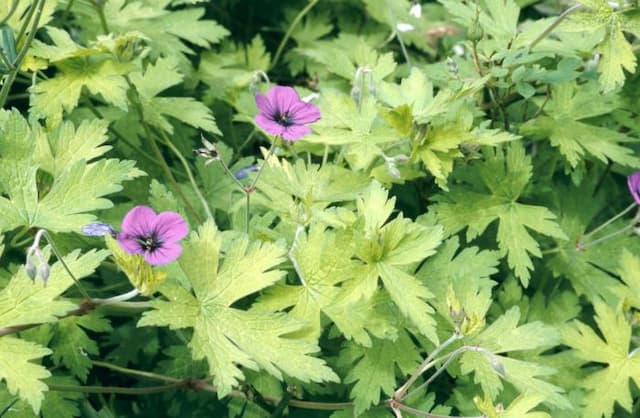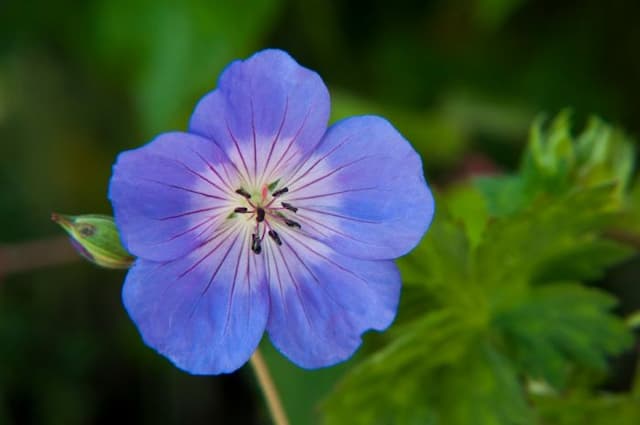Cranesbill Geranium biuncinatum 'Bob's Blunder'

ABOUT
Geranium biuncinatum 'Bob's Blunder' is a distinctive variety characterized by its showy flowers and attractive foliage. The flowers of this Geranium are noteworthy, often having a robust, vibrant hue that may range from pinks to purples, with petals that can be veined or marked with contrasting colors, creating a stunning visual display. These blossoms are borne in clusters and can be quite eye-catching when the plant is in full bloom. The leaves of 'Bob's Blunder' are equally appealing, typically deeply lobed or divided, with a texture that can vary from velvety to more smooth surfaces. The foliage might display green shades that can be bright or darker, possibly with hints of other colors like red or bronze, particularly in the cooler months or on the edges and stems, adding another layer of interest to the plant's appearance. The plant overall presents a neat, mounded habit, forming a rounded shape that is dense and lush. Its branching structure allows it to create a full appearance, with the foliage and flowers complementing each other to create a cohesive visual impact. The Geranium is adaptable and can show significant variation in color intensity and leaf shape among different conditions, making 'Bob's Blunder' a versatile and appealing addition to various garden settings.
About this plant
 Names
NamesSynonyms
Bob's Blunder Geranium, Bicolored Geranium.
Common names
Geranium biuncinatum 'Bob's Blunder'.
 Toxicity
ToxicityTo humans
Cranesbill, commonly referred to by its specific cultivar name Geranium biuncinatum 'Bob's Blunder', generally has a low level of toxicity to humans. Most species of Geranium, including Cranesbill, are not considered poisonous and do not typically pose serious problems if ingested in small amounts. If ingested in larger quantities, however, they may cause mild gastrointestinal upset, including symptoms like nausea, vomiting, or diarrhea. While serious complications are unlikely, it is advisable to refrain from consuming parts of this plant and to seek medical assistance if significant ingestion occurs or if symptoms persist.
To pets
Cranesbill, the common name for Geranium biuncinatum 'Bob's Blunder', is not known to be highly toxic to pets, including dogs and cats. If a pet consumes a small amount of this plant, they may experience mild gastrointestinal discomfort, including symptoms such as vomiting or diarrhea. These symptoms are usually self-limiting and not severe. However, as with any non-food item, it's best to prevent pets from ingesting plants, and if you suspect your pet has eaten a large quantity or if symptoms appear severe or persist, it is important to consult a veterinarian.
 Characteristics
CharacteristicsLife cycle
Perennials
Foliage type
Deciduous
Color of leaves
Green
Flower color
Varies
Height
1.5 feet (45.72 cm
Spread
1.5 feet (45.72 cm
Plant type
Herb
Hardiness zones
5
Native area
North America
Benefits
 General Benefits
General Benefits- Attracts Pollinators: Geranium biokovo attracts bees and butterflies, helping to pollinate nearby plants.
- Low Maintenance: Requires minimal care once established, making it ideal for gardeners of all skill levels.
- Drought Tolerant: Once established, it can survive with less water, which is beneficial in water-restricted areas.
- Ground Cover: It spreads to form a dense mat that can help control weeds and prevent soil erosion.
- Long Blooming: Offers a long season of flowers, typically from spring to early fall.
- Decorative: Adds visual appeal to gardens with its delicate pinkish-white flowers and attractive foliage.
- Adaptable: Can thrive in a variety of soil types, as long as there is good drainage.
- Wildlife Friendly: Provides habitat and food for insects and birds, contributing to biodiversity.
- Non-Invasive: Unlike some ornamental plants, Geranium biokovo is not known to be invasive in natural habitats.
- Seasonal Interest: Offers year-round interest with flowers in warmer months and sometimes red or purple autumn foliage.
 Medical Properties
Medical PropertiesThis plant is not used for medical purposes.
 Air-purifying Qualities
Air-purifying QualitiesThis plant is not specifically known for air purifying qualities.
 Other Uses
Other Uses- Geraniums, including the Geranium biuncinatum 'Bob's Blunder', can be used in potpourri mixes due to their aromatic foliage, providing a pleasant and long-lasting fragrance.
- The dried petals of geraniums can be incorporated into homemade papers, offering a decorative touch and subtle scent to personalized stationery or crafts.
- With their bright and diverse colors, geranium petals can be used as a natural dye for fabrics, yarns, and even Easter eggs, giving them a gentle hue.
- Geranium leaves can be infused in oil to create scented candles or natural room diffusers to impart a fresh and floral aroma to indoor spaces.
- These plants can act as companion plants in vegetable gardens; they are believed to repel certain insects harmful to crops like cabbages and tomatoes.
- Geraniums can be used as cut flowers in floral arrangements, bringing vibrant color and a touch of elegance to bouquets and centerpieces.
- The bright blooms of geraniums are edible and can add a splash of color and a hint of flavor to salads, desserts, and culinary garnishes.
- Geranium leaves can be placed among linens and clothing to impart a fresh scent and possibly deter moths and other insects.
- Pressed geranium flowers and leaves can be used in crafting, such as in the creation of bookmarks, cards, or decorative elements in scrapbooking.
- Geranium plants can be grown as ornamental groundcovers in gardens, providing dense foliage and continuous blooms that can suppress weeds.
Interesting Facts
 Feng Shui
Feng ShuiThe Geranium is not used in Feng Shui practice.
 Zodiac Sign Compitability
Zodiac Sign CompitabilityThe Geranium is not used in astrology practice.
 Plant Symbolism
Plant SymbolismGeranium biuncinatum 'Bob's Blunder', commonly known as Geranium:
- True Friendship - Geraniums are generally associated with true friendship, reflecting stability and deep emotional bonds.
- Happiness - The bright and varied colors of geranium flowers are symbolic of happiness and positive emotions.
- Good Health - Geranium plants have been used traditionally for their medicinal properties, symbolizing wishes for good health and well-being.
- Peace - With its calming fragrance, geraniums are often associated with peace and the tranquility of the mind.
- Harmony - The balanced growth habit of geraniums represents harmony and balanced relationships in one’s life.
 Water
WaterCranesbill, which is the common name for Geranium biuncinatum, prefers consistently moist soil but does not like to be waterlogged. Water the plant deeply once a week, providing about one to one and a half gallons per watering during growing seasons, spring through fall. During the hotter months or in drier climates, you may need to water more frequently, possibly twice a week. During winter, reduce watering to every other week, depending on the plant's environment and whether it's kept indoors or outdoors. Always check the top inch of the soil before watering; if it feels dry, it's time to water.
 Light
LightCranesbill thrives in a position where it receives full sun to partial shade. The ideal spot for this geranium would be where it can bask in at least four to six hours of sunlight daily, although it can tolerate some shade, especially in hot climates. Avoid placing it in deep shade, as this can lead to poor flowering and leggy growth.
 Temperature
TemperatureCranesbill favors moderate temperatures and will do best in conditions ranging from about 60 to 75 degrees Fahrenheit. It can survive lower temperatures down to around 20 degrees Fahrenheit, but growth will be dormant, and frost can damage the plant. During summer, if temperatures consistently exceed 85 degrees Fahrenheit, the plant may appreciate some afternoon shade to avoid stress.
 Pruning
PruningCranesbill should be pruned to encourage bushier growth, remove dead or damaged foliage, and maintain its shape. The best time for pruning is early spring or after the plant has finished its main flowering cycle. Deadheading, or removing spent flowers, can be done throughout the blooming season to promote further blooming. Prune about once a year or as needed to remove any woody or leggy stems.
 Cleaning
CleaningAs needed
 Soil
SoilThe best soil mix for Hardy Geraniums, which is the most common name for Geranium biuncinatum 'Bob's Blunder', is well-draining soil enriched with organic matter. A mixture of loam, peat, and perlite or sand can provide the ideal structure for robust growth. These plants prefer neutral to slightly acidic soil, with an optimal pH range of 5.8 to 6.8.
 Repotting
RepottingHardy Geraniums like Geranium biuncinatum 'Bob's Blunder' should be repotted when they become root-bound, usually every 2 to 3 years. It's best to repot in the spring before active growth begins, choosing a pot only one size larger than the current one.
 Humidity & Misting
Humidity & MistingHardy Geraniums, including Geranium biuncinatum 'Bob's Blunder', do well in average household humidity levels. They do not require particularly high humidity environments; maintaining usual room humidity will suffice for these adaptable plants.
 Suitable locations
Suitable locationsIndoor
Place in bright, indirect light and water when topsoil is dry.
Outdoor
Plant in partial sun with well-draining soil and water regularly.
Hardiness zone
5-9 USDA
 Life cycle
Life cycleGeranium biuncinatum 'Bob's Blunder', also known as Cranesbill 'Bob's Blunder', starts its life as a seed, which upon proper conditions, germinates typically in the spring. It develops a rosette of leaves at ground level before a stem with lobed leaves emerges, marking the vegetative growth stage. As it matures, the Cranesbill produces distinctive flowers, usually in a shade of purple or violet, during the flowering stage where pollination occurs, often facilitated by insects. After pollination, the flowers develop into beak-like seed capsules, and once mature, these capsules expel the seeds forcefully, ensuring seed dispersal. The plant may go into a dormancy period during the winter, depending on the climate, conserving energy by shedding leaves. In the subsequent growing season, the Cranesbill 'Bob's Blunder' resumes vegetative growth, thus repeating its life cycle.
 Propogation
PropogationPropogation time
Spring-Summer
Propogation: Geranium biuncinatum 'Bob's Blunder' is commonly propagated through stem cuttings. To do this effectively, the best time is in late spring or early summer when the plant is actively growing. Choose a healthy stem and cut a segment about 4 to 6 inches (10 to 15 centimeters) long, making sure there are a few leaves on the cutting. Remove the leaves from the bottom half of the cutting to expose the nodes where roots will develop. Dip the cut end in rooting hormone to encourage root growth and insert it into a pot filled with a well draining soil mixture. Keep the soil consistently moist but not waterlogged and place the pot in a bright area with indirect sunlight. Roots typically establish in a few weeks, after which the new geranium can be transplanted.









